Media | Articles
We Drive Vintage Scouts 800 Miles to the Groundbreaking for the New Plant
The International Harvester Scout was ahead of its time. But that time ended in 1980, after 20 years of IH building the Jeep-like vehicle. So, what happened then, to cause the death of the Scout? What’s happening now, to the Scouts that remain? And finally, what will happen in the future, now that Volkswagen has acquired the Scout name, and is building a $2 billion factory to make electric Scouts?
We had the opportunity to visit Fort Wayne, Indiana, the home of the Scout, and to drive five vintage Scouts more than 800 miles to the groundbreaking of the new factory in South Carolina. Following is the first of three stories outlining the past, present, and future of this automotive icon. -Ed.
In January of 2020, Hagerty announced that the International Harvester Scout, model years 1971 through 1980, had been named to our annual Bull Market List of 10 vehicles likely to soon appreciate in value.
From that article: “The Scout is the last of the affordable classic sport-utes. American rivals such as the Ford Bronco and Chevy Blazer have out-appreciated the Scout, but its values are on a steady climb, the result of enthusiasts realizing they can have the same amount of fun and curb appeal for a fraction of the Bronco price. Low buy-in, high ceiling. To steal from a slogan from an old Scout advertisement: ‘There are times you just don’t compromise.’ This could be one of them.”
So where did the Scout go wrong?
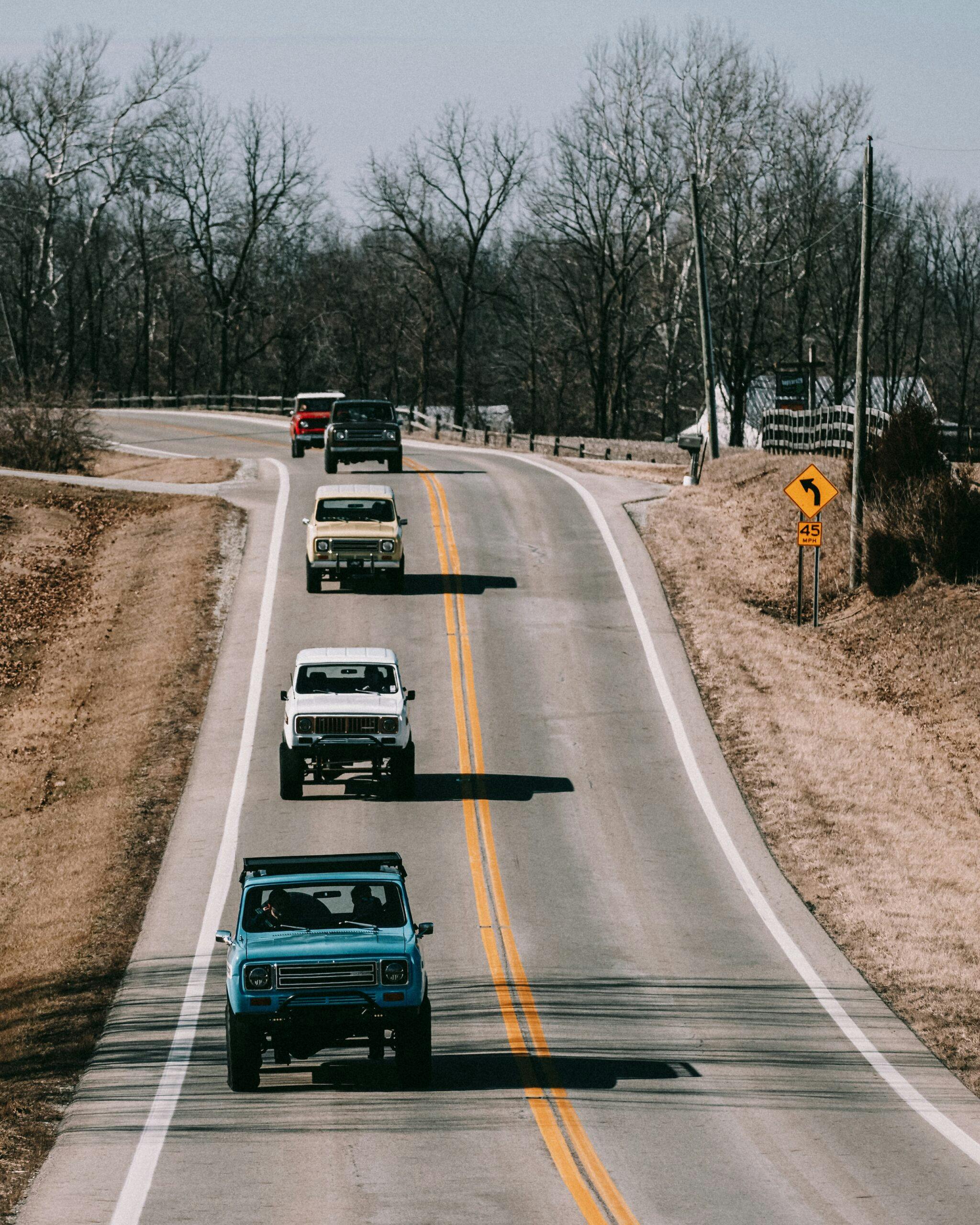
Marketplace
Buy and sell classics with confidence
The story begins in Fort Wayne, Indiana—since 1923 decidedly an International Harvester company town. IH, best known for farm equipment and heavy-duty vehicles, was formed in 1902 amid the merger of several companies. Five years later, IH built the first “Auto Wagon,” essentially an early pickup truck. In 1916, a truck built by International Harvester became the first vehicle to climb Pikes Peak.
In 1953, IH began building the Travelall, a big four-door sport utility vehicle, decades before that term was coined. It was based on the IH pickup chassis. It was an early competitor for the Chevrolet Suburban and the Jeep Wagoneer, though that model wouldn’t start production until nine years later.
In the late 1950s, IH decided to put a smaller vehicle into production. It wanted to call the small truck the Scout, but a manufacturer of tank-like vehicles used in the frozen tundra had trademarked the name. International Harvester paid the owner $25,000, and on March 1, 1960, the trademark became the property of IH. Nine months later, the first IH Scout rolled off the assembly line.
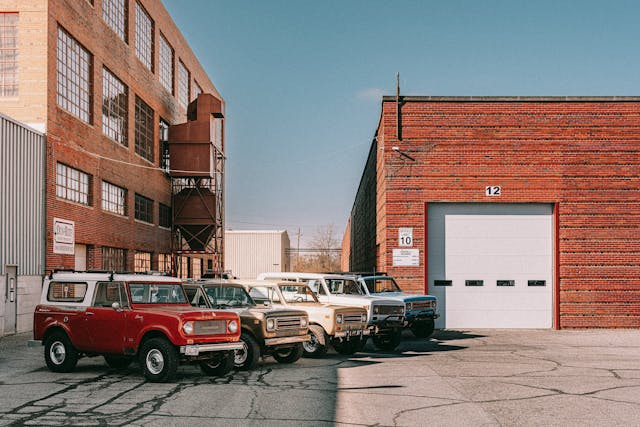
On October 21, 1980, some 532,673 Scouts later, the final Scout, a Tahitian Red, diesel-powered, four-speed Traveltop, ended the 20-year history of the International Harvester Scout. The plant went silent.
There were multiple reasons why—a slowing economy, a downturn in IH’s core farm equipment sales—but most agree that the final nail in the Scout’s coffin was a brutal six-month United Auto Workers strike that started in November of 1979, reportedly costing the company nearly $600 million. Afterwards, International Harvester tried to sell the Scout division but there were no takers. Had IH hung on for a few more years, the Scout would likely have been swept up in the SUV craze that has yet to abate.
But the Scout was dead. It appears, though, that there may be life after death, and that’s what the rest of this series is about.
***
I flew into Fort Wayne International Airport on a Sunday afternoon in a puddle-jumper jet from Charlotte. Volkswagen Group, now the owner of the Scout name acquired when VW bought Navistar, which is what was left after International Harvester splintered into several companies in 1985, had arranged the trip. VW rounded up five original Scouts, model years 1967 to 1979, and mapped out an ambitious route of more than 800 miles that would take us to a few Scout landmarks and down some muddy trails en route to Blythewood, South Carolina. There, we would join some dignitaries, including the state’s governor, for the groundbreaking of the 1100-acre factory slated to build the future electric-powered Scouts trailblazing the brand’s rebirth.
Three journalists took up this opportunity, and we were joined by a half-dozen employees of Scout Motors, which is what the new company is called. Also making the trip: Sean and Heather Barber, owners of Anything Scout—an Ames, Iowa business catering to Scout owners with parts and custom builds. Sean owned three of the five Scouts we’d be driving. If anything went wrong, he’d help keep us out of trouble.
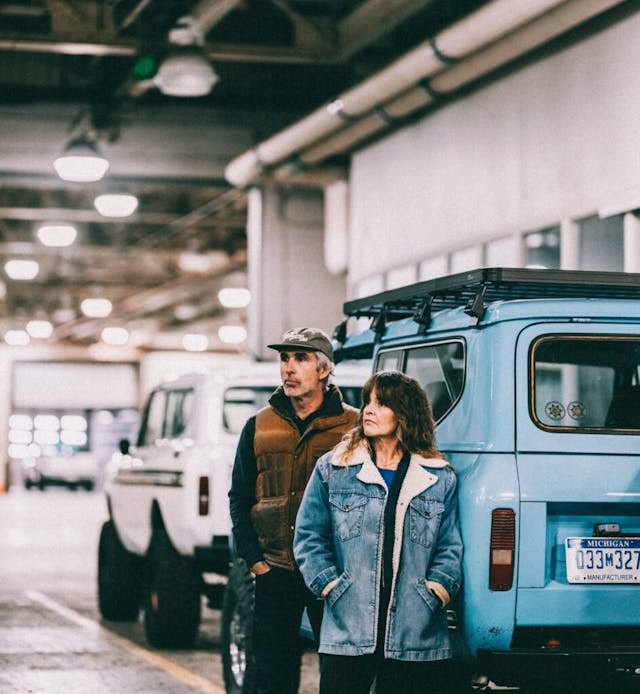
We left Monday morning, and the first stop was the old IH plant. We departed The Bradley, our hotel for the night in downtown Fort Wayne, and headed southeast toward Meyer Road, once a bustling urban area. When International Harvester was operating at full song, it employed 10,600 people.
Now, a chain-smoking guard for Allied Security appears to be the only one who still works there. He watches the maze of mostly empty red-brick buildings, abandoned since 2012 when what was left of the jobs moved to Chicago. The last International Harvester truck was built there on July 15, 1983. Since the factory opened more than 100 years ago, 1,527,299 trucks were built in Fort Wayne. The plant even had its own test track.
We drove into the rear of the buildings and headed through a maze until we were led down a wide aisle. Suddenly we were flanked by vintage Harvester products. This is the Fort Wayne Truck Works & Industry Museum, and its co-founder, Ryan DuVall, greeted us.
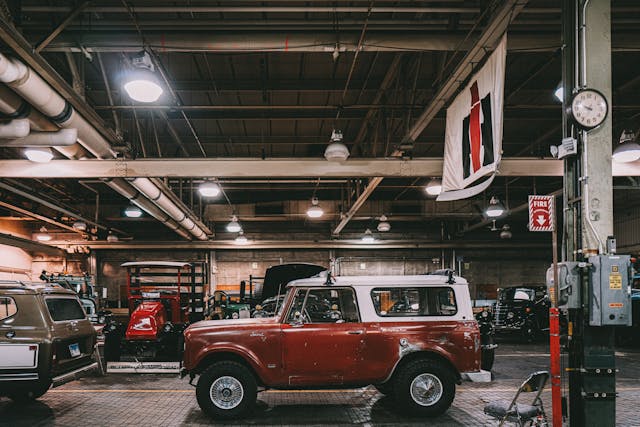
DuVall lived elsewhere when he became a Scout fan. A rusty, passed-down 1974 Scout II that his father drove became DuVall’s first vehicle at age 16. Years later, he acquired another, less-rusty Scout. He moved to Fort Wayne in 1999 and mentioned to his father, via phone, that he was seeing a surprising number of well-kept Scouts on the road.
“’You dummy!’ his father told him. ‘That’s where they were made!’” DuVall had no idea. He began researching the history of IH in Fort Wayne and found the plant where Scouts were built, just across the street from the main complex. It’s another red-brick building, now occupied by American Hydroformers, maker of high-pressure tubing. That building once held engineering offices for Studebaker’s aircraft engine works. Indiana-based Studebaker built some pretty formidable engines, including those powering the World War II B-17 Flying Fortress bomber—four 1200-horsepower, nine-cylinder radial engines per airplane.
In 2018, DuVall wrote a column for The Journal-Gazette, Fort Wayne’s newspaper. He expressed surprise that Harvester’s impact on the city isn’t celebrated: “Given their place in history as basically the first SUVs and the fact that they remain very popular among the classic truck and off-road crowd,” DuVall wrote, “I have always been disappointed and kind of puzzled as to why the city hasn’t marked Harvester’s imprint better. The old empty factory is about all there is here. There is no Scout museum and no significant memorial to the company here.”
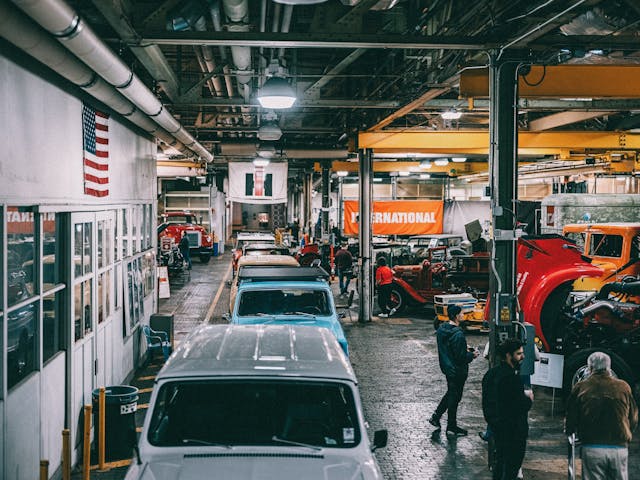
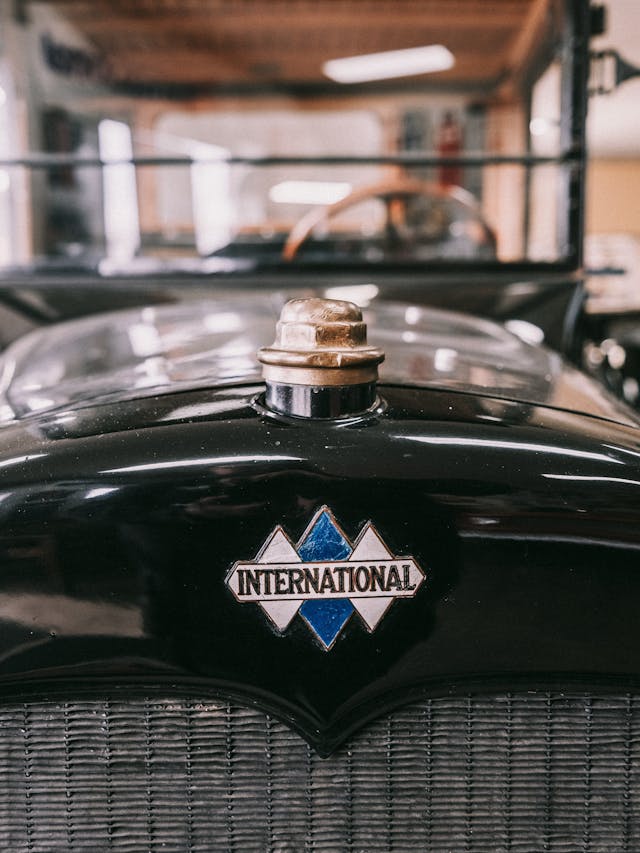

That’s possibly because bitterness remained over so many lost jobs, and Scout production ended shortly after that devastating UAW strike. Nonetheless, DuVall’s story struck a chord. He was contacted by multiple residents who agreed with his perspective and suggested he was the man who should lead an effort to recognize Harvester’s history. Multiple volunteers offered to help, and the city government, local philanthropists, and businesses financed it. Thus was born the Harvester Homecoming, an annual celebration held on the first weekend in August.
The first Harvester Homecoming was held at the old IH plant on Meyer Road in 2019. “We had 12,000 people, and we stopped counting trucks at 438, at 10 a.m. Saturday morning. And they kept coming all day long,” DuVall recalled. The next step was creating the museum. Navistar, the Volkswagen-owned offshoot of IH, had a collection of vehicles warehoused in Chicago, intending to perhaps open a museum someday. They moved most of them to Fort Wayne, and that’s the collection that surrounded us. It ranges from a 1907 Auto Buggy (which was followed in 1908 by the Auto Wagon, IH’s first truck) to a tractor made to tow an 18-wheeler, powered by a Cummins Signature 600 15-liter diesel.

As appropriate as this place is for the museum, DuVall said the location’s time is unlikely to be permanent. The buildings are now owned by the county, which is trying to build a jail on the property. DuVall said he’d prefer the museum stay, but that the building is 74 years old, high-maintenance, and it costs $10,000 a month to heat in the winter. Plus, “We’ve been presented with an opportunity that may make it not matter.” Translation: A new potential site for the collection.
He made it clear, though, that Harvester Homecoming, an event so potent for IH fans that an owner once drove his Scout from Alaska to attend, will continue. The community has become a family. “That’s the kind of thing this brand does,” he said. “It brings people closer together. Especially the Scouts. You can’t get away from it.”
Before we left, the Scout Motors executives accompanying us were gifted a dark red brick from the original plant, presented by Jim Poiry, who managed the Scout plant, as well as the Fort Wayne Truck Works. His grandfather sold his farm to International Harvester in 1920, and that’s where the Truck Works plant was built prior to its opening in 1923. Apparently, Scout Motors was expecting the brick: The executives placed it gently in a hard plastic carrying case which appeared to be designed to hold exactly one brick, with a clear plastic lid so you could see it inside.
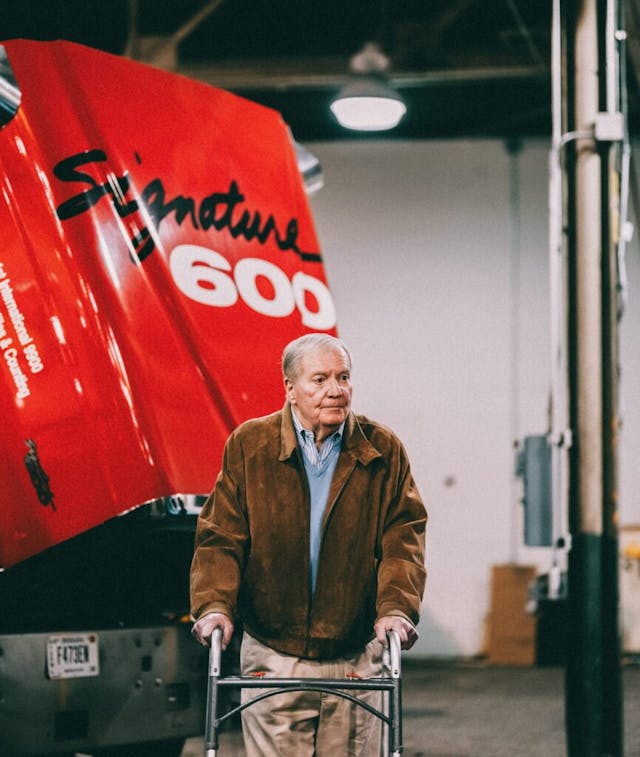
We took turns hauling the brick all the way to Blythewood, South Carolina, where it would slide into a lectern that stood on the stage for the Scout Motors plant groundbreaking ceremony—a lectern built with a brick carrying-case slot in front. It was ceremonial but apparently important that a small piece of the original International Harvester plant take up residence in the new Scout Motors factory. I, owner of two vintage Scouts, was the first to carry the brick; I kind of just sat it on the floor of the passenger side of the old Scout I was driving and forgot about it.
After we left the museum, we drove across the street to American Hydroformers and parked our Scouts in front of a white sliding door at the end of the building. After they were built, all of the Scouts in our care drove out that door.
***
On mostly two-lane country roads, we headed 105 miles southeast towards Enon, Ohio, population 2500. It’s a location well known among those restoring or maintaining International Harvester Scouts, pickups, or Travelalls. Enon is home to Super Scout Specialists, a parts house and restoration shop for vintage IH vehicles that opened in 1990. The outfit has since grown to 46,000 square feet and includes its own museum.
That’s where we met Super Scout Specialist owner John Glancy and freelance author Jim Allen. Together they wrote The International Scout Encyclopedia: The Authorized Guide to IH’s Legendary 4×4, published by Octane Books. The buildings are modest on the outside, but on the inside—and behind the buildings, in what is essentially an IH boneyard of picked-over vehicles—we found a real time capsule.
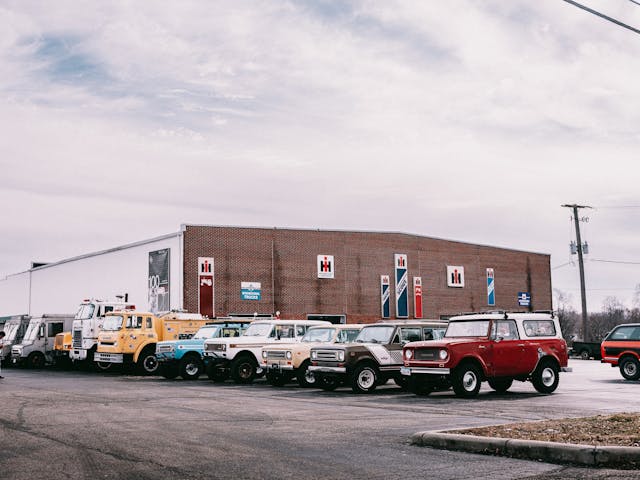

The museum’s centerpiece is the first production Scout ever made—a little blue and white pickup powered by a four-cylinder engine. Surrounding it are shelves stocked with new, reproduced parts for Scouts, and in the cavernous back room there are original parts in boxes or stacked on racks. We saw a big rack of old hoods, a shelf with dusty instrument panels, and a wall where salvaged grilles were hung.

As old Scouts grow in popularity, the demand for Glancy’s services is growing. Still, “It’s getting tougher, day by day,” he said. “But we’re still here. The interest has increased, but it’s more of a challenge. A lot of our suppliers are wanting us to buy larger quantities than we can afford. If we can’t, they disappear, and we have to go find new suppliers.”
He agreed that Scouts are worth more than ever. “The value has gone up. When our book came out, I knew that would happen. It educated people about all the special models. I really think it helped.”
He was unsure, he said, about any impact the new Scout Motors electric vehicles will have on the old Scouts. “It’s bringing attention to the original models, what they are calling legacy Scouts. But I don’t know if it’s going to do anything for the value, any more than what the new Bronco did for the old Broncos. I will give Scout Motors credit—they seem to be genuinely interested in the history.”
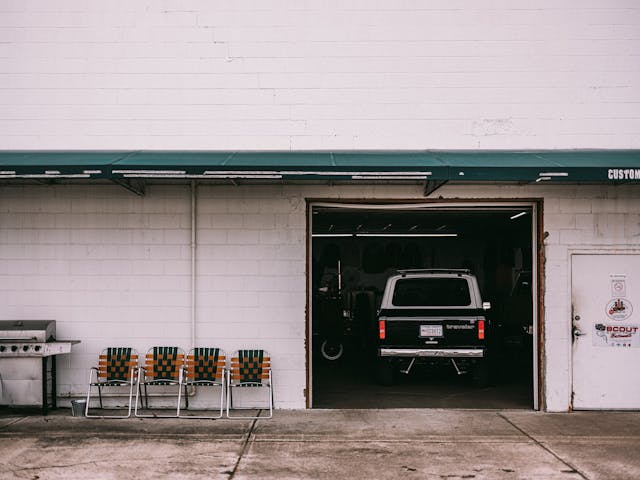
Co-author Allen, who has been writing about four-wheel-drive vehicles for decades, said interest in Scouts has decidedly increased. “I started out as a four-wheel-drive historian. I knew a lot about it, and Scouts were part of that. I had wanted to do a Scout book back in the early ‘90s, but I couldn’t get a publisher interested in it.” Now, the International Scout Encyclopedia has become the bible for enthusiasts.
Value has also risen. “Oh, big time. In the last 10 years, the last five especially, Scouts have just gone berserk. The prices they are getting for Scouts now—here I am, the guy who wrote the book about Scouts, and I can’t afford to buy one. It’s insane what they’re getting for them.”
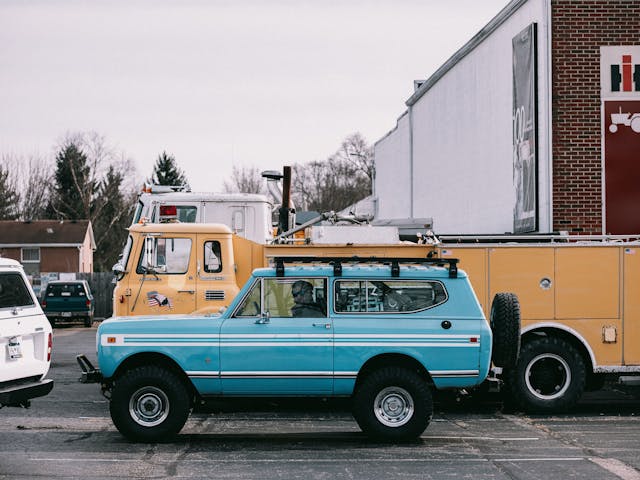
Hagerty valuation data reflects these reports, but our data experts note that the Scout still lags behind the early Bronco. Making the most progress is the Scout II, which was built from 1971 through the end of the Scout run in 1980, and accounts for four of the five Scouts we were driving. Based on the average Hagerty Price Guide value, all variants of 1961-72 Scouts have increased by 57 percent (from $17,702 to $27,879) in the past five years, while all variants of 1972-80 Scout IIs have increased by 62 percent (from $20,943 to $33,890).
Scout fans, Allen said, tend to fall into one of two categories: “There’s the restoration crowd, and the build-up crowd. And I think the build-up crowd is getting bigger than it used to be,” with seriously lifted vehicles and motor and transmission transplants. “A 302- or a 345-cubic-inch V-8 isn’t good enough, it has to have a Chevrolet LS engine in it. I’m not sure I get it: Why go back to the thrilling days of yesteryear, if you’re not really going back to the thrilling days of yesteryear?”
The restoration crowd “is narrow-focused. Interested in the details. Very much perfectionists in how they deal with their restorations. That’s what keeps John in beans and cornbread, the people who buy parts from him.”

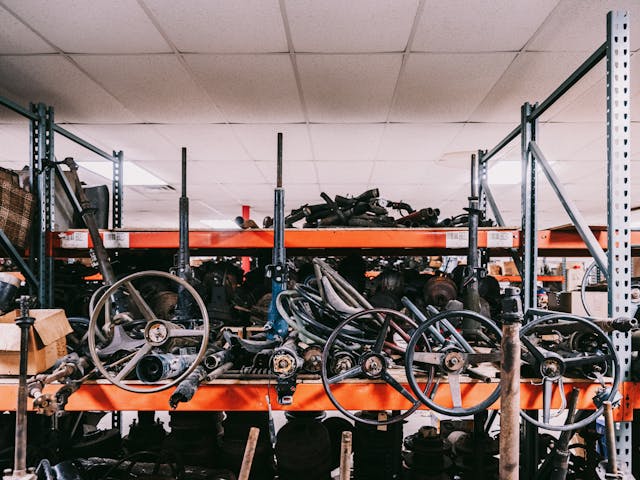


Scout fans “were always the other guy,” Allen said. “There was a time, before the Ford Bronco came out in 1966, that Scout owned a big chunk of the SUV market, though of course they weren’t called SUVs then. But that market segment did exist. That’s what got the Scout going. It was more of a daily driver than the main rival, Jeep. Then, Jeeps were bare-bones in the extreme. The Scout was a step beyond that.”
How will fans of the original Scout take to an electric-powered one? “Most of the old guard has a problem with it,” Allen said. “But they appreciate the fact that the company has a legitimate interest in preserving the history, and they want it represented honestly.”
Tomorrow, we’ll find out how well the original Scouts adapt to interstate travel, on- and off-road.
***
Check out the Hagerty Media homepage so you don’t miss a single story, or better yet, bookmark it. To get our best stories delivered right to your inbox, subscribe to our newsletters.



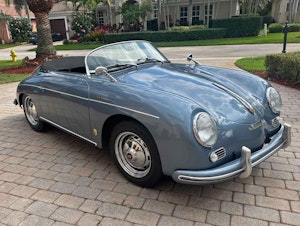

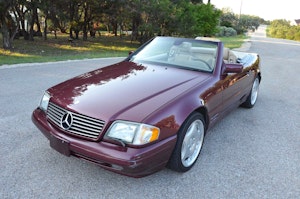




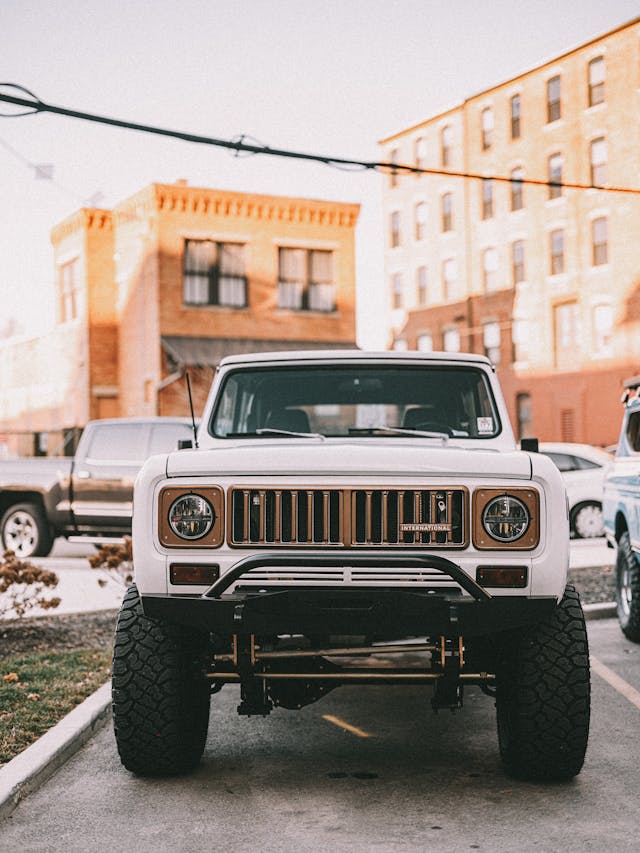

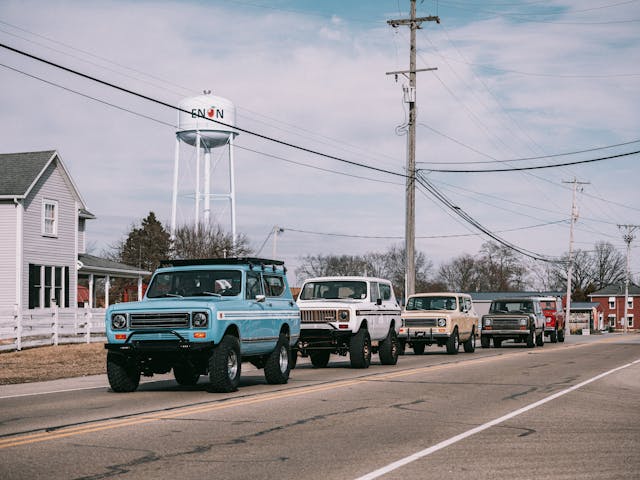
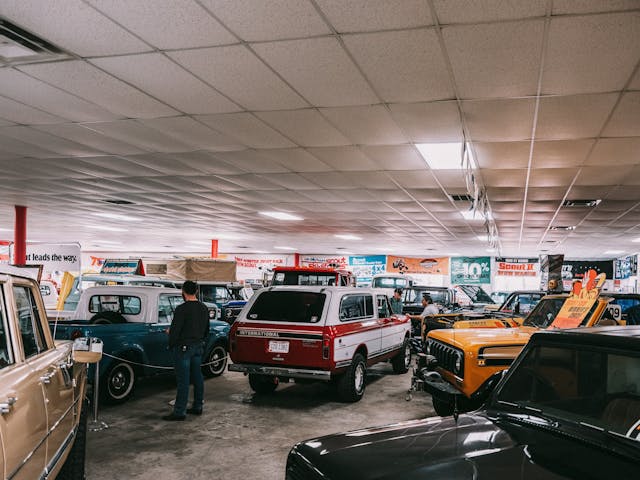


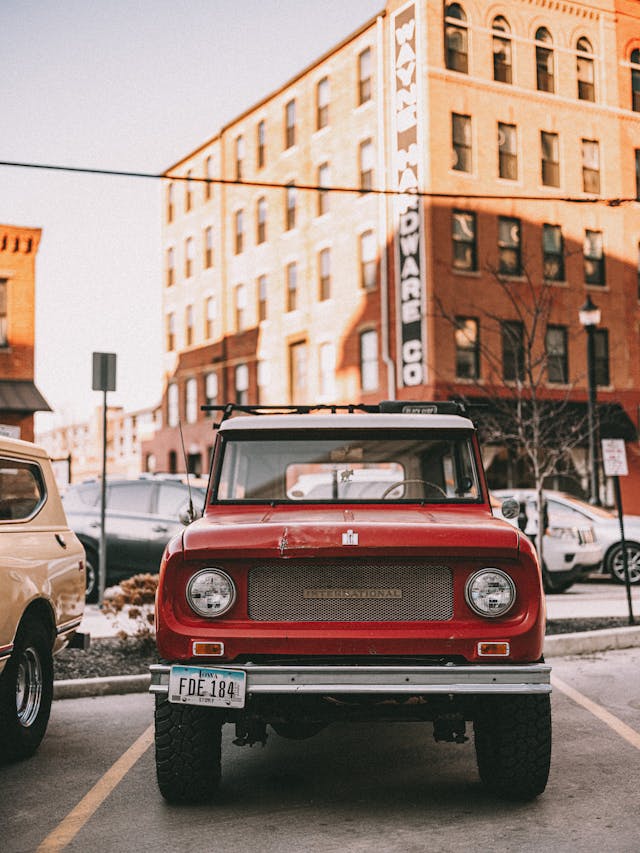
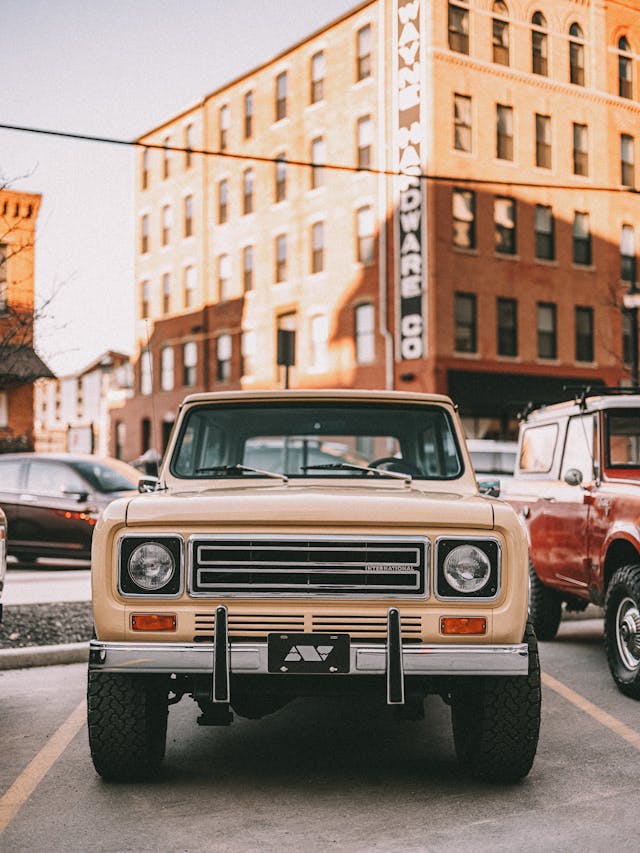



























Why is the baby blue scout wearing a Michigan manufacturer’s plate? Is it actually a preproduction unit from Scout Motors?
No, it’s one of the ones owned by Sean Barber of Anything Scout. Not sure why it has that plate — we haven’t seen anything from Scout Motors except some vague line drawings.
As owner of an old Jeep, I wish the Scout and International history buffs well. Glad they are keeping the brand alive.
Up here in the Northwest, you still see old Scouts unrestored and working. A neighbor in my rural neighborhood has one with a plow. I guess many people haven’t heard the word about collecting SUVs.
I know of another guy with a ancient Land Cruiser that still plows.
I would have thought that would have priced itself into retirement and restoration by now.
Anyone one else a bit uncomfortable with the idea that big companies are recycling historic names to give their new (electric) vehicles a bit of un-earned heritage?
First GM’s Hummer and now VW’s “Scout”.
Seems very cynical to me.
JohnB I am interested in buying bone my daughter wants to follow my steps. Can you help locating one. Please let me know your zip code I can search also.
Scout friend.
I had a 73’ model Scout with 304 V-8, wish I had never sold it. If these new ones were being made with internal combustion engines I would buy one but I will never, never, ever buy an electric vehicle. Too many electric vehicles catching on fire and they are worthless in freezing weather!!!
I can’t imagine the battery pack will enjoy being banged around a rough trail either, no matter how much vibration insulation they add to it.
I drove one in my high school years, my father bought my first vehicle on my freshman year. Color solid baby blue lifted it with 10 inch shackles so the 12-15 tires would fit. Loved it. (1976) Edinburg High School I had the only Scout in the school.
Memories 🇺🇸
My son owns a 1971 Comanche he bought from his wife’s grandfather. It has rusty rockers but runs and drives. I hope he restores it soon.
https://www.classiccarstudio.com/inventory/1971-international-scout-comanche-2013/
Thanks for link and memories. I bought a used 1966 Scout when I was a senior in high school which I traded in on a used 1971 Comanche. That vehicle took me from the Dakotas to College in Idaho and back to the Dakotas. I loved that vehicle but the numerous trails and off-road led me to trade it on a new FJ-40 in 1977. I never did take a shine to the Scout II. That FJ was driven by both my kids in high school and I still have that same FJ parked in the garage. I now drive it only in the summer and plan on a total restoration soon. I wish I still had that Comanche though. Tell your son he’s lucky to have one.
I’m not a scout owner but I do love them. Some nice ones near me. I do not look at a new VW EV as a Scout. It has no real connection besides a name they purchased.
What a wonderful article! Looking forward to the rest of them. As a fellow four wheel drive historian (my specialty is Broncos), it was great to see Jim Allen quoted extensively along with a nice picture of him and John. Jim is the pinnacle of knowledge when it comes to vintage 4x4s of all types.
My family had a ’67 Scout for a few years before we got our Bronco and one of my uncles drove a ’73 Scout II – many, many fond memories of riding around in the backcountry in that rig.
My dad worked for IH back in 70’s and 80’s in Chatham, Ontario, Canada. Employees had the chance to buy Scouts at a discount. He brought a half dozen or so home but never pulled the trigger on any. I was so ticked man. Lucky my best friend in high school, his dad was like 3rd from the top in mgmt. He got a new every 6 months. We used to go out and try and get stuck in the winter-what a blast. I wasn’t a party-er so this was my fun. Our last year of high school his dad got a 1980 Scout II hunter green/black vinyl interior one. I wish I woulda begged my dad to take a loan out on my behalf for that one. Seriously that one getting way haunts me. Years later I bought a 78 Scout Traveler with midas option. Pretty cool. 4 buckets. The front ones swivelled towards the back seats. Interior quarter trim and headliner decked out like an RV. My 2 labs used to sit in the back seat like people. People would pass me smiling-and then I realized they were chuckling at my dogs sitting like the king and queen back there. Good times!
I remember that Scouts around here seemed a little top heavy and many had to be tipped upright now and then. Also, when we had a large dairy farm we dug a swimming pond which all our neighbors used. We also had a tough International 4 wheel drive, one ton pickup. A great farm truck! One day my wife took a load of our kids and neighbor kids down to swim. As she was leaving she noticed a fishing pole in the way. Jumped out, removed it and then the truck rolled into the pond with kids jumping out like rats from a sinking ship. It sat there about half sunk with IHC sparkling on the tailgate. My wife sent one of our daughters up to the barn where I was working. “Just tell your Dad bring a tractor, nothing else”. Something told me to also take the camera. That photo was in every rotary slide tray we had and appeared at all our slide shows.
The tough old truck just needed it’s oil changed and everything else checked out. Then it went back to work for us. I should never have sol it.
The story mentions a museum, but I can’t find any information about it. The Harvester Homecoming website doesn’t seem to have been updated since sometime last summer. Does anyone know whether the event is still going on, and whether there is anything open to the public to visit? I was working on the Scout line, Dept. 53 when it shut down, then moved over to the cab-over and conventional line for a few months before IH gave us all the big boot. If I remember, there were about 7000 of us laid off one that day. I spent those 6 months on the picket line, even though up until then we were getting great pay, great benefits, and didn’t have any gripes with IH. I generally support unions, but the UAW seriously f***ed us that time. They had a vendetta against IH and we all lost out big time.
I should have said Dept 97. But hey, it’s been 45 years.
Hmmm. Wonder why they are building plant in South Carolina?
A press conference was held after the 800-mile driving tour, but none of the drive participants could hear any of the questions.
Bought a New 1976 Red White and Blue, Spirit of America Scout II. Had a Blue convertible top with factory roll bar. The roll bar sticker said ” Not for Roll Over Protection” Well, I rolled it one night and it worked great, pushed it back on all fours and drove it home a little bruized up!
Unions destroyed the big three in Detroit. And they still are not producing anything but junk. Japanese or German products are better and built. Most big three cars and trucks are built in Mexico for cheap labor